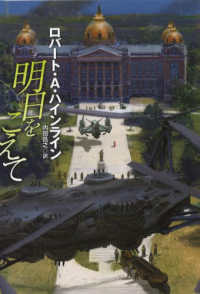- ホーム
- > 洋書
- > 英文書
- > Literary Criticism
Full Description
Kashefi's Anvar-e Sohayli (15th c. A.D.) is a Persian rewriting of the timeless and influential Kalila wa-Dimna text, done at the Timurid court. Christine van Ruymbeke offers a first in-depth analysis of the contents and style of this important text and also addresses the Kalila wa-Dimna field across its full rewriting history. This analysis shows how Kashefi's additions function as an invaluable commentary that opens up our understanding and the appreciation of this seminal text. This studies revisits several received ideas and current misapprehensions about the text and shows why it has been such an international best-seller before being unjustly relegated to children's literature. In Van Ruymbeke's words, Kalila wa-Dimna is a grim text, exposing the mechanisms of sophisticated psychological manipulation and exploring universal philosophical themes, known since Antiquity and still relevant today.
Contents
PREFACE
LIST OF ANVAR-e SOHAYLI STORIES AND SUB-STORIES and TAXONOMY
PART 1: KASHEFI COMPOSES THE ANVAR-e SOHAYLI
1. The Author and the Patron
1.1 Abject Hosayn, the Preacher known as "The Discloser"
1.2 Shining Sohayli, the Patron
1.3 "The proper function of the critic is to save [the text] from the artist who created it." (D.H. Laurence)
2. The Contents of Kashefi's Dibacheh
2.1 On how to read the text and on who is supposed to read it
2.2 The noble hereditary line
2.2.1 The Anvar's asnad,
2.2.2 KD as classified data
2.2.3 Zopyros, the Wandermotiv of the mutilated hero
3. Rewriting Nasrollah Monshi's KD version,
3.1 Neither Parricide nor Plagiarism
3.2 But: Cannibalism, Mimesis and Appropriation
3.2.1 Traipsing like a Partridge
4. The Subject Matter of the AS
5. The Table of Contents
5.1 "A title must muddle the reader's ideas, not regiment them." (U. Eco)
5.2 Exit Borzuyeh
5.3 The fourteen chapters
5.3.1 The Whisperer holds the pedagogical centre-stage in the first chapter
5.4 The Envoi
PART 2: BEING PERNICKETY ABOUT "ANIMAL FABLES"
1. Fussing about "Fables"
1.1 And what about Logos pseudes eikonizoon aletheian?
1.2 The Lion and the Hare (I,13)
1.3 Redundant or impertinent pro- and epimythia?
2. Nit-picking on Zaban-e vohush?
2.1 Homo homine lupus
2.2 Characterisation's lack of significance
2.3 The brutes speak!
2.4 And what do they say?
3. Animals as unclear emblems
3.1 Sophisticated psychological anthropomorphism
3.2 Never mistake a jackal for a fox!
3.3 Kalileh's parrhesia vs. Demneh's rhetoric
4. A bevy of human actors
4.1 "If I state quite frankly..." (O. Wilde)
4.2 Misogynous characterisations?
5. Humans and Animals
5.1 Plausible human-animal interaction
5.2 Improbable vocal contact between man and bird
5.3 The metamorphoses of the Mouse-girl (IV,11)
6. Why write "animal stories" for a political audience?
6.1 Back to the contrapuntal and impertinent pro- and epimythia
6.2 The story-telling technique
6.3 Animals to say the unsayable?
6.4 Frank and oblique speech
6.5 Storytelling as a methodology of political theory
PART 3: THE BIGGEST BEES IN KASHEFI'S BONNET: A THEMATIC ANALYSIS
1. De Regimine Principum
1.1 The "Governance of Princes"
1.2 "Praeterea regem non sic Aegyptus et ingens Lydia nec populi Partharum aut Medeis Hydaspes observant"
1.3 Regicide most foul!
1.4 A rigid class system?
1.5 Pigeonholing the professional vizier and the occasional hermit advisor.
1.6 The forces of destiny and God's selection of his instrument
2. Seeking Useful Friends and Genuine Comrades
2.1 As an Elephant in the Quagmire
2.2 The Player's and the Soother's parting
2.3 Kalileh's suicide and Demneh's new friend
2.4 The Ring-Dove and the Friends (III)
2.4.1 The Mouse, Monsieur Perrichon and the Ben Franklin effect
2.4.2 The Mouse and Maslow's Hierarchy of Needs.
2.4.3 The Two Real Friends (III,7)
3. Introducing the Trickster-Rhetorician
3.1 Grading the rogues: from soft trickster to sinister murderer
3.1.1 The Hare as the archetypal confidence man
3.1.2 The Queen's strategic self-sacrifice
3.1.3 The horrendous Zahhak-theme
3.2 The virtues of the tongue
3.2.1 Kashefian Iago? Demneh's subversion of rhetoric.
Part 4: BUILDING APPRECIATION FOR "TASTELESS BOMBAST"
1. Kashefi's "degenerate style"
1.1 Linguistic torture?
1.2 More than only "terpsichorean pirouettes of syntax and thought"
1.3 Kashefi's energising metaphor
1.3.1 In the oven
1.3.2 Wondrous Thoughts on Poetical Tropes
1.4 The antimetabola's cognitive significance
2. Prosimetrum
2.1 Prosimetrum: partim prosa partim metro componens
2.2 Like salt in the pot
2.3 The ancillary intertextual aspect
2.4 The function of the inclusions
2.5 Enlightenment in absentia
3. The effect of the verse quotations and 'eqtebas
3.1 A pedagogy of recognition
PART 5: TOPICAL WEB; STRUCTURAL MAZE
1. The new, double outer frame
1.1 "Providing no key to the origin of the book"
1.2 Kashefi's innovative frame-stories
1.2.1 The story of the vizier Khojasteh-Ray and the king Homayun-Fal (FS I)
1.2.2 The story of the sage Bidpay and the King Dabshalim (FS II)
1.2.3 Wrapping up each frame
2. The fourteen main stories
2.1 Stating the Chapters' pedagogy
2.2 KD/AS's elusive internal architecture
2.3 The stories' structure as an essential tool for their pedagogical aim
3. The embedded sub-stories
3.1 The joys of aviation
3.2 Thematic criss-crossing
3.3 The sub-stories' relation to the embedding narratives
3.4 The sub-story as a miniature main story
3.5 Kashefi adds the story of the two Companions Ghanim and Salim (I,2)
3.6 Kashefi's additions to Ebn-e Madin and the Lark (VIII)
4. Shiruyeh knew that the first chapter is the book in a nutshell
PART 6 THE SKELETON
1. A skeleton in the cupboard of Persian literary studies
2. Sir William's Sugarchest
3. A Language exercise
PART 7 A COLLABORATIVE EFFORT. THE NOBLE HEREDITARY LINE OF KALILEH-DEMNEH VERSIONS AND TRANSLATIONS IN THE PERSIAN TRADITION.
1 Concerns, questions and even some exasperation
2 The lost Sanskrit text
3 Borzuyeh's lost Middle Persian KD
4 The Old Syriac Version
5 Ibn al-Muqaffa''s Arabic KD
6 Bal'ami's and Rudaki's opus geminum
7 Nasrollah Monshi's Persian KD prosimetrum
PART 8 CONCLUSIONS
BIBLIOGRAPHY
INDEX







